The NVIDIA SHIELD Tablet Review
by Joshua Ho on July 29, 2014 9:00 AM ESTCPU Performance
As the first Tegra K1 device the Shield tablet is especially interesting. For those unfamiliar with the Tegra K1, NVIDIA integrated four ARM Cortex A15r3 variant cores along with a fifth companion A15r3. While on the surface it seems the CPU configuration it’s largely similar to the Tegra 4, there are some substantial differences. On the process tech side, the move to 28HPm adds SiGe source and drains for PMOS transistors, which dramatically improves drive current and makes it possible to bump clocks up to 2.2GHz for the CPU cores. The new revision of Cortex A15 also means that there’s better power management which should help with power efficiency (and thus battery life). The result is that peak CPU voltage drops from 1.4 volts in Tegra 4 to 1.2V in Tegra K1, and peak clocks are higher in the K1 as well.
Of course, the truly interesting aspect are benchmarks, as those will really show the differences between Tegra 4 and Tegra K1. It will also help to establish how Tegra K1 fares against the competition.
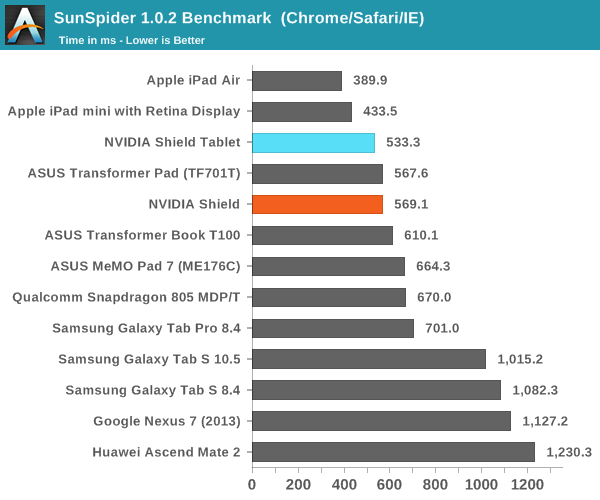
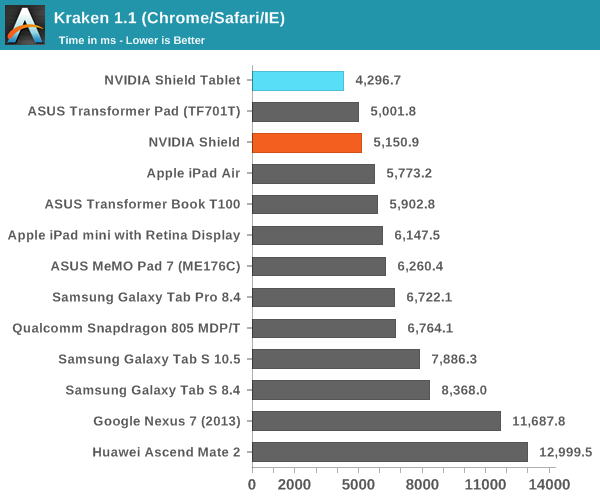
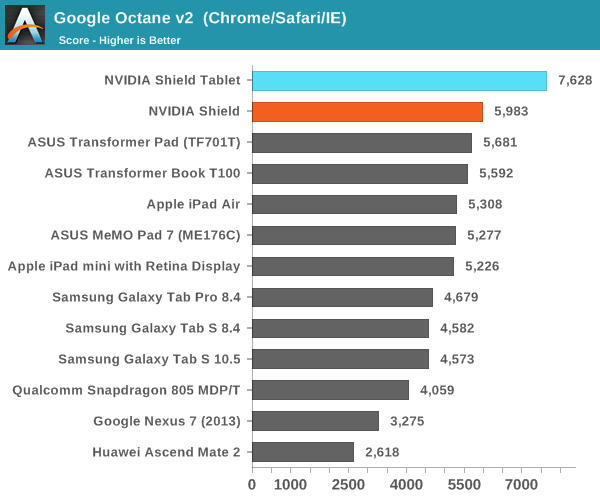
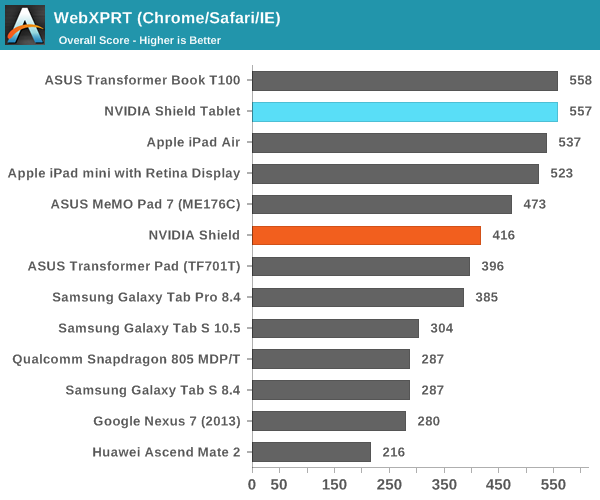
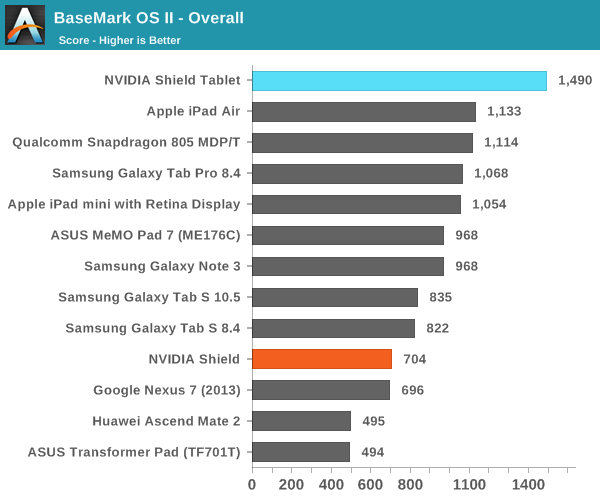
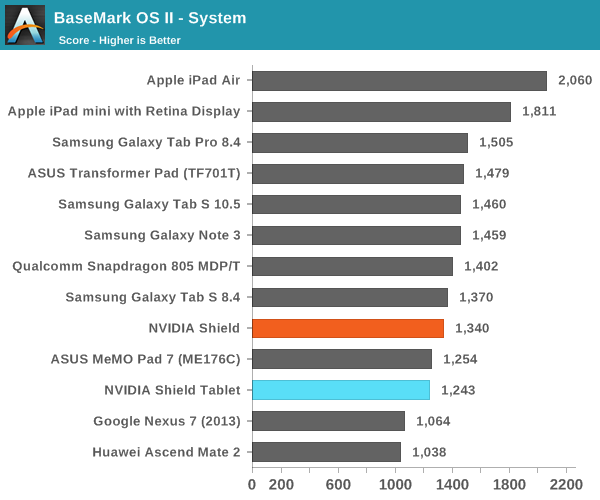
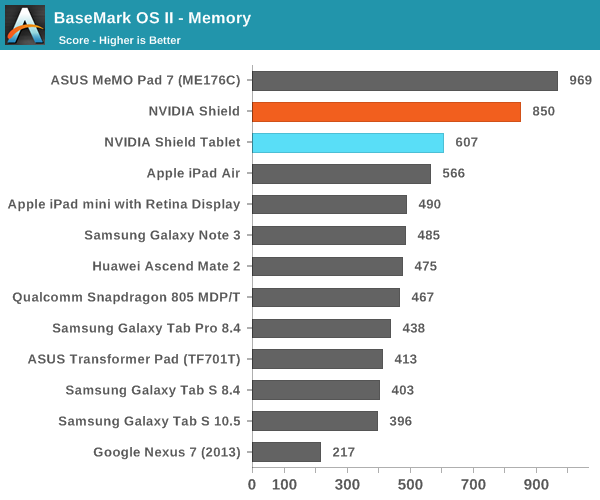
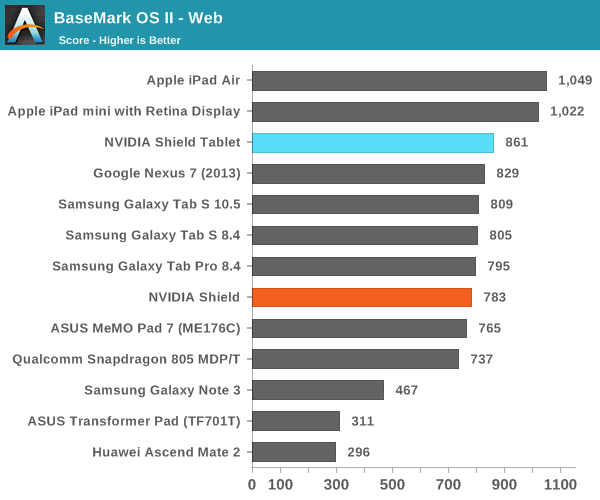
Despite the largely similar clock speeds compared to the Snapdragon 800 we see that the Tegra K1 is generally a step above in performance. Outside of Apple’s A7 SoC and x86 SoCs, NVIDIA is generally solidly ahead of the competition. Of course, as a gaming tablet there’s a strong need for GPU performance, so we'll look at that next.










174 Comments
View All Comments
TheJian - Wednesday, July 30, 2014 - link
Full 3.1 ES support and OpenGL 4.4. Being based on desktop gpus it should become a very good emu platform over time. I wonder if a 20nm M1 would be totally able to play wiiu games too? I find myself wanting to hold out for a 20nm version of NV's chip for a serious boost in power for gaming since android seems to be really taking off in this area. I couldn't justify a tablet before just as a tablet, but my list of android games I want to play is growing so might have to bite soon. Dad's nexus 10 isn't good enough for many things (dang res being too high). I hope NV sticks with 1080p/1200p for a while so gaming just gets better not slower on android. Above this is just stupid in something under 13in with gaming as an intention.Another review showed it running emus and Zelda Ocarina of time.
http://gizmodo.com/nvidia-shield-tablet-review-a-g...
Mupen64. Dolphin guys will probably adapt it to K1 soon I'd guess. The power and features are there. N64 games work at least according to gizmodo guy. I'm not really interested in anything before n64's time but there's some pretty fun stuff on n64 or better I wouldn't mind playing today (never owning any nintendo product previously).
Knowname - Wednesday, July 30, 2014 - link
the controller is certainly as uncomfortable as an n64's *bazinga*NZtechfreak - Monday, August 18, 2014 - link
Dolphin will run, on time trial mode (no other racers onscreen) in Double Dash it gets 40-60fps, with high 40 to high 50s the majority of the time. Haven't yet tried a lot of other stuff. The Dolphin developers are really looking forward to the 64-bit K1.bossmoogle - Tuesday, July 29, 2014 - link
I'm considering one of these but for me an important factor that wasn't discussed in the review was the glass on the display. I'm guessing it's not GorillaGlass. Is it scratch resistant at all? I'm on a Nexus 7 2013 right now and the GOrillaGlass is just amazing, if I wipe my screen off it still looks pristine as if it had just gotten off the assembly line. Not a single micro scratch is visible in the sunlight. Once you've used something like that it's very hard to go back to a screen you know is going to get all scratched up.schizoide - Tuesday, July 29, 2014 - link
The nexus7 2013 actually uses Corning's "Fit" or "Concore" glass, which is not as scratch resistant as corning gorilla glass.I researched it briefly but was unable to find what the shield tablet uses. So I agree that it's probably not gorilla glass, or they would have said so.
kron123456789 - Tuesday, July 29, 2014 - link
Good thing about games on this tablet is that Tegra K1 optimized games are using desktop OpenGL, not mobile OpenGL ES.kidconcept - Tuesday, July 29, 2014 - link
> Of course, the real question here is whether the gaming side is worth the price premium.Can you mention some other tablets the Shield has to compete with on price? For example, the Nexus 7 costs about $60 dollars more than the Shield (16GB +$70, 32GB-LTE +$50). Anything else in the same class as the Shield that is significantly cheaper?
Great review BTW. Hit all the important points for most of the audience. As an artist, I'm curious about how the stylus performs, but I recognize that nobody else really cares about it.
schizoide - Tuesday, July 29, 2014 - link
You've got that backwards. The Nexus 7 16GB retails for $230 and the Nexus 7 32GB model with LTE at $350.The nvidia shield tablet 16GB retails for $300, and the 32GB model with LTE will sell for $400.
schizoide - Tuesday, July 29, 2014 - link
Also like I posted earlier, if you're OK with manufacturer refurbs, you can pick up a N7 16GB refurb from an authorized reseller for $140 on eBay. Half the price.kidconcept - Tuesday, July 29, 2014 - link
Refurbs isn't really a great price comparison.